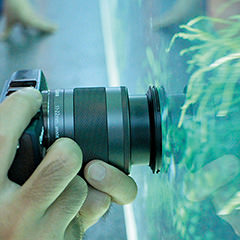Have you ever had the experience of wanting to capture fishes swimming in an aquarium but realized that the resulting shot was blurry as the surroundings were too dark, or you were unable to capture everything in the image as there was not enough space for you to move back? In this article, Seiji Mizuno, a lecturer for the "Camera Biyori" Workshop, will share how to capture charming aquarium photos using the EOS M, a mirrorless model that provides reassuring support for shooting at dimly-lit locations, paired with the EF-M11-22mm f/4-5.6 IS STM, a wide-angle zoom lens that is known for producing fascinating wide-angle shots. (Written & Organized by: Camera Biyori Editorial Department)

Satisfactory Results of Details and Movement

A jellyfish tank. The blue light that brightens the entire water tank, together with light that enters the water from above, adds a fantastical feel to the jellyfish.

Combining the EOS M with the EF-M11-22mm f/4-5.6 IS STM lens allowed me to produce this clear, high-definition image. The fine and transparent tentacles are clearly reproduced, and remain sharp even when the image is enlarged.

Penguins swimming around energetically in the water. With the firmware update of the EOS M, AF speed has become faster, enabling lively shots like this to be taken as well.
Tips for Successful Aquarium Photos
Tip 1: Raise sensitivity to prevent blur

At a dimly-lit place where the shutter speed tends to slow down, both camera shake and subject blur are likely to occur. Thus, to increase the shutter speed, select a high "ISO speed." However, note that raising the ISO speed excessively may cause noise to occur, so an ISO speed setting of about ISO 3200 is recommended.
Tip 2: Use Image Stabilizer (IS) function to prevent blur (2)

With a correction effect equivalent to about three shutter speed stops, this feature offers reassuring support to photography under low light conditions. To ensure that the resulting shots are fail-proof, simply take precautions such as holding the camera firmly with your elbows pressed against your body, resting your arms on a nearby stand or railing, or leaning your body against a wall.
Tip 3: Prevent capturing reflections from the tank

If you are worried that reflections from the tank may be captured, take a shot with the lens in close contact with the glass surface of the tank. While doing so, ensure that the lens is at a right angle to the tank to prevent the resulting image from appearing distorted. Using a wide-angle allows you to capture a sufficiently wide area even when the lens is in contact with the tank surface.

EOS M (Firmware updated) & EF-M11-22mm f/4-5.6 IS STM (35mm format equivalent: approx. 17.6-35.2mm)
The EF-M11-22mm f/4-5.6 IS STM, a lens designed for the compact and lightweight mirrorless EOS M is a wide-angle zoom lens that captures a wide area .It boasts clear expressive power, while at the same time allows you to enjoy charming bokeh effects in close-up shots at a closest focusing distance of about 15cm. Yet another characteristic is its compactness and lightness that are comparable to the EF-M18-55mm f/3.5-5.6 IS STM standard zoom. With the update of the EOS M firmware, the camera has become even much easier to use than before with a faster AF speed. Combining the use of a new lens, there is no doubt your photographic experience will be further enhanced!
* This article is created based on a trial model. Aspects such as the appearance and image quality may differ slightly from the actual product. Also the body color introduced here for the EOS M is currently available only in a limited area.

Camera Biyori is a Japanese photography magazine introducing charming photos and daily joy with cameras. Suggesting fun activities relating to cameras and photography, Camera Biyori editorial department also offer the "Camera Biyori Photography School" to recommend its readers to engage in photography and have fun.
Published by Daiichi Progress Inc.
































